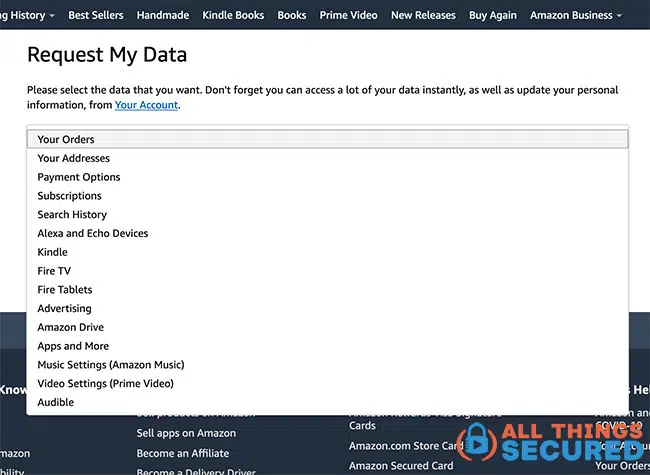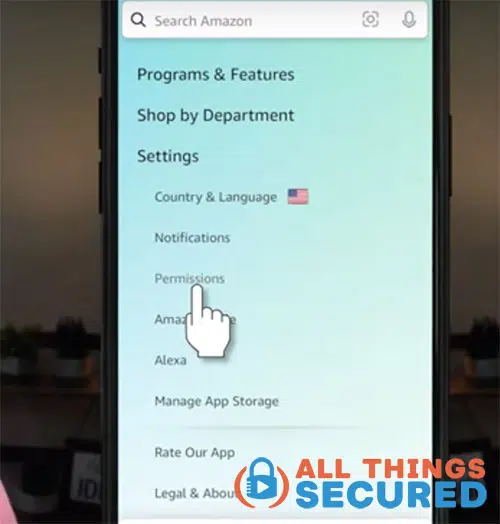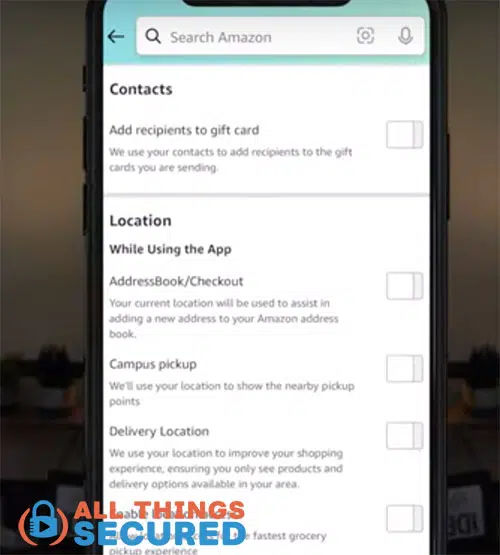We all know that Amazon tracks our purchases (online), our reading habits (Kindle), our entertainment preferences (Prime Music & Video), our daily requests (Echo) and even our home visitors (Ring). But there are two important questions we need to ask: how exactly is Amazon tracking us? And how do we stop them?

At this point, most people are aware that companies like Amazon, Google and even Facebook are data hungry. But you don’t have to take my word for it.
Amazon will tell you themselves.
What Data Does Amazon Collect?
If you go to Amazon’s website to request my data, you know what they give me? They give me a drop down menu of 15 different tracking categories to choose from.

Amazon collects a vast amount of data from its customers, encompassing everything from personal information to detailed usage patterns across its various services. This includes your browsing history, search queries, and purchase history.
When you use services like Prime Video, smart devices, or the virtual assistant Alexa, Amazon collects data to enhance your experience.
But it doesn’t stop there. Amazon also gathers data from its own services, such as Amazon Web Services (AWS), and from third-party sellers on its platform. This data is crucial for personalizing your shopping experience, improving their services, and targeting advertising more effectively.
Additionally, Amazon collects data from its subsidiaries, including Ring, Whole Foods, Twitch, IMDb, and Audible, to create a comprehensive profile of your preferences and behaviors.
How Amazon Tracks Your Data (3 Ways)
Amazon tracks and collects data on you in three unique ways:
As users interact more with Amazon’s services, more data is collected, raising concerns about privacy and data security.
Let’s dive into each of these individually.
Data We Voluntarily Give Amazon
The first and most obvious way is the data we voluntarily give them.
We browse their website, use their apps, purchase products, give them our credit card info, address for delivery and so on. Obviously, in order for us to make purchases and have them delivered, providing this kind of data is necessary. They haven’t stolen that data or taken it without your knowledge. This data is not only used to facilitate transactions but also to sell products more effectively by understanding customer preferences.
The point here is that Amazon isn’t doing anything underhanded here. They’re literally just storing the troves of information you’re giving them.
Our Metadata Amazon Collects
The second type of information Amazon collects, which I’ll call your metadata, is a bit shadier.
I mean, sure, it makes sense that they track what kind of products you’re looking to buy, but they also track metadata such as:
- The device you’re using (iOS, Android, mobile, desktop, etc.);
- Your IP address, which provides your general location;
- Recordings of every request made of Alexa;
- Log of every record of motion on your Ring doorbell log;
- Every scroll and click you make on the website;
- Detailed logs of reading sessions on Kindle, including the exact timing of each tap.
Now Amazon has said in their privacy policy that they are not in the business of selling this data to anybody else, so you don’t really have to worry about that.
But the kind of profile they’re able to build on us is alarming and it’s one of many reasons why regulators are trying to break up big tech companies.is alarming and it’s one of many reasons why regulators are trying to break up big tech companies.
Advertising Data Provided by 3rd Party Companies
The third type of information Amazon collects on you is what they receive from 3rd-party companies.
Examples of this external data would be stuff like:
- Your credit history from credit bureaus as part of their fraud prevention;
- Information from third-party delivery companies;
- Data from their subsidiaries;
This data is often shared with other providers to enhance service delivery and improve customer experience.
Who are Amazon’s subsidiaries, you ask? Well did you know that Amazon owns Diapers.com, Zappos, Twitch, IMDb and Whole Foods Market among about 40 others companies?
Although the connection between your interactions with these companies and your Amazon file might not be as direct, it does exist.
Accessing Your Amazon Data
If you’re curious about what data Amazon has on you, you can access it through a data subject access request. To start, log into your Amazon account and navigate to the “Your Data” section under Privacy Settings. Here, you can submit a request for your personal data. Amazon will then send you a follow-up email to confirm your request.
Once processed, you’ll receive a notification to download your data package. Be prepared; this package can be quite large and is typically organized into folders, often in formats like CSVs. To make sense of it all, you can search through the data by copying the paths in the captions, giving you a detailed look at the information Amazon has collected about you.
Amazon’s Data Storage Practices
Amazon stores user data in a network of data centers around the world, known as Amazon Web Services (AWS). These data centers are strategically located on six continents, including major hubs in the U.S., Europe, and Asia.
For instance, Northern Virginia alone hosts more than 70 of Amazon’s data centers, making it a significant hub for data storage.
When choosing locations for their data centers, Amazon considers various environmental and geographic factors to ensure optimal performance and security. The company’s data storage practices are designed to protect the security and integrity of user data, employing robust measures to guard against data breaches and unauthorized access.
The Impact of Amazon’s Data Collection
Amazon’s data collection practices have far-reaching implications for both its customers and the broader world. By leveraging artificial intelligence and machine learning algorithms, Amazon can analyze customer data to personalize shopping experiences and target advertising more effectively. However, this extensive data collection also raises significant concerns about privacy and the potential for misuse of personal information.
For example, Amazon’s facial recognition technology, Rekognition, has faced criticism for its potential to lead to wrongful arrests and increased surveillance. The company’s data collection practices also impact its competitors and the retail industry at large, as Amazon uses its vast amounts of data to inform business decisions and maintain a competitive edge.
As Jeff Bezos famously said, “Data is the new oil,” and Amazon is undoubtedly at the forefront of this data-driven economy.
How to Stop Amazon from Tracking You
And if at this point you’re not at least a little bit concerned about the data Amazon has on you, I don’t know what to tell you.
For the rest of us, though, let’s talk about whether or not it’s possible to stop, or at the very least limit, what Amazon can track about us. Regulations like the General Data Protection Regulation (GDPR) in the EU provide some measures to limit data collection and enhance privacy.
Extreme Solution: Delete Amazon Account
Ok, here’s the bad news. The only way to stop Amazon from tracking you completely is to delete your Amazon account.
I’m serious.
It’s extreme. It’s crazy. And for most people living in the US, it’s practically impossible. I know there are a few of you who are willing to live without the convenience that Amazon provides, but I’m going to assume that most of us aren’t willing to take that drastic step.
So if we’re not going to delete our Amazon account, what other options do we have?
Easiest Solution: Limit Data Settings
You’re welcome to search around, but you won’t find a “Privacy Settings” section in your Amazon account.
What you will find isn’t much. For those in the EU, thanks to GDPR, you have the option to set custom cookie preferences, which are those pieces of code that follow you around to show you personalized ads. You can also turn off interest-based ads. US consumers, on the other hand, only have the option to turn off interest-based ads, we’re not given custom cookie preferences. Adjusting these settings can limit the amount of advertising data Amazon collects, thereby reducing targeted ads.
I’ll be honest, though, neither of these are a big deal. Amazon’s still tracking you, the only difference is that the ads are dumber.
Amazon Privacy Settings on Mobile Devices
You have a bit more control on a mobile device, though. If you go into your Amazon app and click on the three bars on the menu, find where it says “Permissions”.

This is where you can easily turn off Amazon’s ability to use your Bluetooth, your location, your camera, your microphone, and your photos.
Frankly, there’s not one setting in this Permissions menu that I turn on, but then again, I’m not the kind of guy who likes to use my camera to virtually try on products, so I’m ok with that.

Unfortunately, both Audible and Kindle don’t offer much in terms of privacy controls. I mean, you can remove the Reading Insights dashboard on Kindle, but it doesn’t actually change any data Amazon collects, it just removes it from my sight.
The same goes for turning off your browsing history when logged in on your desktop. Just because you can’t see it doesn’t mean Amazon isn’t tracking it.
Amazon Privacy Settings on Other Devices
There is, however, a bit more control if you’re the owner of an Alexa or a Ring product. Each family of products has their own privacy hub where you can delete recordings and manage any privacy settings, so I recommend you do that.
You may have also heard of something called Sidewalk, which is Amazon’s attempt to use their devices as a mesh network to create a public WiFi. If you have an Echo device made after 2016 or a select number of Ring devices, then listen carefully.

Personally, I don’t see any good reason why I want to have my home devices broadcasting free WiFi around my neighborhood, so Amazon Sidewalk is an easy no for me. Turn it off in the Alexa or Ring app account settings.
And well, I hate to say it, but that’s about all you can do on this easiest level of Amazon privacy control.
There are a couple other little things here and there that I won’t go into detail here, things like editing your Amazon public profile or turning off the Echo drop-in settings, but at this point it’s clear that none of this is really affording us any extra privacy at all.
We’re just limiting who can see it.
Middle Ground Approach to Amazon Privacy
Ok, here comes the good part. If you’re not willing to delete your Amazon account but you’re also not comfortable with all the data Amazon collects, what is that middle ground option?
Well, there’s a bit of nuance to this answer, but here are a few easy places to start.
First, when you’re searching to buy something on Amazon, use a web browser that automatically blocks third party cookies. In other words, some sort of Google Chrome alternative browser.
Next, I would make sure that the browser I use to shop is not the same browser I use to buy, and that the browser I use to shop isn’t logged into my Amazon account so they can’t connect my account with my browsing history. You could even go a step further and have a different device for browsing and for actual buying.
An Amazon spokesperson has stated that the company is committed to protecting user privacy and does not share data with third parties without consent.
Now let’s say you want to go even a step further. You could pay for your Amazon purchases using a virtual credit card and have Amazon send all packages to a virtual address.
Now for the sake of my marriage, I don’t go this far, because when my wife orders something on one- or two-day delivery, she expects to get it in one or two days. A virtual address can’t do that.
But this just goes to highlight how difficult it is to erase your footprint on Amazon. They allow you to download your data, but the only way to delete the data Amazon has on you is to completely close your account.
Be sure to subscribe to the All Things Secured YouTube channel!

